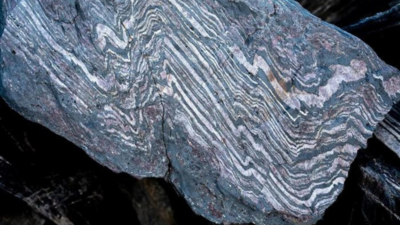- News
- Science News
- Geologists uncover ancient rocks revealing Earth's earliest magnetic field dating back to 3.7 billion years
Geologists uncover ancient rocks revealing Earth's earliest magnetic field dating back to 3.7 billion years

An example of 3.7 billion year-old banded iron formation found in the northeastern part of the Isua Supracrustal Belt (Credits: Claire Nichols)
NEW DELHI: Geologists from MIT and Oxford University have made a significant discovery in Greenland, unearthing ancient rocks that hold clues to Earth's earliest magnetic field.
These rocks, well-preserved, offer insights into conditions on Earth billions of years ago. Researchers determined them to be approximately 3.7 billion years old, showing remnants of a magnetic field with a strength of at least 15 microtesla, comparable to today's magnetic field.
Published in the Journal of Geophysical Research, the findings mark some of the earliest evidence of Earth's magnetic field, potentially pushing back its age by hundreds of millions of years. Understanding the planet's magnetic history could provide crucial insights into its early environment and the emergence of life.
Claire Nichols, an associate professor at Oxford University, highlighted the significance of Earth's magnetic field for its habitability. “It’s thought our magnetic field protects us from harmful radiation from space, and also helps us to have oceans and atmospheres that can be stable for long periods of time”, Nichols said.
The experiment also indicated that the rocks maintained their magnetic properties through significant geological events. Around 3.7 billion years ago, the iron in the samples likely crystallized during an initial thermal event. Subsequent reheating events, approximately 2.8 billion years ago and 1.5 billion years ago, did not erase the rocks' magnetization entirely.
This discovery opened new avenues for understanding Earth's ancient magnetic field and its role in shaping the planet's early environment.
These rocks, well-preserved, offer insights into conditions on Earth billions of years ago. Researchers determined them to be approximately 3.7 billion years old, showing remnants of a magnetic field with a strength of at least 15 microtesla, comparable to today's magnetic field.
Published in the Journal of Geophysical Research, the findings mark some of the earliest evidence of Earth's magnetic field, potentially pushing back its age by hundreds of millions of years. Understanding the planet's magnetic history could provide crucial insights into its early environment and the emergence of life.
Claire Nichols, an associate professor at Oxford University, highlighted the significance of Earth's magnetic field for its habitability. “It’s thought our magnetic field protects us from harmful radiation from space, and also helps us to have oceans and atmospheres that can be stable for long periods of time”, Nichols said.
While previous studies suggested a magnetic field dating back 3.5 billion years, this research extends its lifespan by an additional 200 million years. Despite undergoing two subsequent thermal events, the rocks retained their ancient magnetic signatures. This suggests that even extreme events, such as tectonic shifts or hydrothermal activity, couldn't completely erase the rocks' magnetic history.
The experiment also indicated that the rocks maintained their magnetic properties through significant geological events. Around 3.7 billion years ago, the iron in the samples likely crystallized during an initial thermal event. Subsequent reheating events, approximately 2.8 billion years ago and 1.5 billion years ago, did not erase the rocks' magnetization entirely.
This discovery opened new avenues for understanding Earth's ancient magnetic field and its role in shaping the planet's early environment.
End of Article
FOLLOW US ON SOCIAL MEDIA

